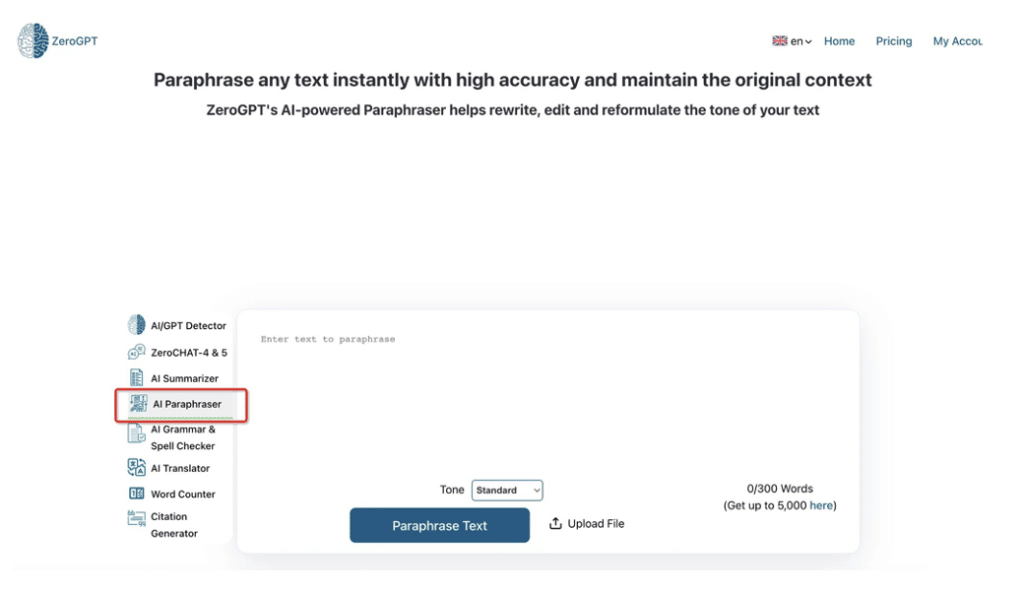As artificial intelligence (AI) technology advances, tools such as ChatGPT and GPT-4 are increasingly capable of generating content that mirrors human writing with remarkable accuracy. This technological progress, while exciting, presents new challenges in content verification. Ensuring that the content we consume and produce is authentic has become more crucial than ever. ZeroGPT emerges as a premier solution in this context, distinguished as an advanced AI checker and paraphraser. This article delves into how ZeroGPT excels in AI content detection and verification, outlining its features, applications, and future prospects.
Contents
- The Increasing Importance of the AI Content Verification
- How ZeroGPT can be the best choice for users as an AI Checker and Paraphraser
- Advanced Detection Techniques
- User-Friendly Design
- Applications Across Various Fields
- Media and Publishing
- Education
- Corporate Sector
- Enhanced Detection Features
- Broader Integration
- Conclusion
The Increasing Importance of the AI Content Verification
The latest models that can be seen in ChatGPT and GPT-4 for instance have been developed to a point that it becomes very challenging to distinguish the works of human writers from the work of the AI writers. When these AI systems work, their articles can be very deceptive and it is possible to be hard to determine where they came from. In this regard, the need for dependable instruments to validate content and hence the validity of the work cannot be overemphasized. We note that in addressing this need, ZeroGPT AI checker employs state of art technology that is efficient in the detection and verification of AI-generated content.
How ZeroGPT can be the best choice for users as an AI Checker and Paraphraser
Among the applications related to AI content verification, ZeroGPT has benefits as an AI checker as well as a paraphrasing tool.
Here’s how ZeroGPT achieves this:
Advanced Detection Techniques
Thus, ZeroGPT uses the following strategies for content analysis. Taking into account that there are particular language indicators characteristic to texts written by machine, it analyzes syntax, grammar, and vocabulary in order to make proper conclusions. The tool is not restricted to analyzing the content at its face value; rather it consider the semantic depths and contextual proprieties of the passage.
User-Friendly Design
ZeroGPT is designed with user accessibility in mind. Its intuitive interface allows users—from journalists and educators to business professionals—to perform detailed content analysis without requiring specialized technical knowledge. This ease of use makes ZeroGPT a practical tool for a wide range of applications, enabling users to quickly verify the authenticity of content.
Applications Across Various Fields
ZeroGPT has versatile applications across multiple sectors, reflecting its broad utility in content verification:
Media and Publishing
The dishonesty check and the authenticity of the articles, reports and other related communications depend much on ZeroGPT in both the media and publishing houses. In this manner, ZeroGPT enables the reduction of the distribution of fake news and plays a part in preserving the credibility of posted information as well as promoting reliable journalism.
Education
In education context, ZeroGPT is helpful for an educator to detect an assignment or research paper produced by AI. This capability is important for maintaining the academic standards and to be able to distinguish whether the students’ submissions are their own work or copied from elsewhere.

Corporate Sector
For businesses, ZeroGPT is beneficial when it comes to ensuring that the message to be passed by the marketing department or the corporate communications department has not been plagiarized. It is therefore important for continuous content that is generated and used to be original to help the businesses continue building credibility while avoiding counterfeit or plagiarized content.
Enhanced Detection Features
That is why; in future releases of ZeroGPT, new detection features for more advanced AI-generated content may be introduced. This could extend the tool to cover other formats within multimedia and interactive formats thus increasing its utility and relevance.
Broader Integration
From this study, it should be possible to predict that later versions of the ZeroGPT will connect to external ecosystems more extensively. This would extend the integration even more which would make the content verification even more possible across all digital platforms.
ZeroGPT’s paraphrasing tool is a powerful feature designed to assist users in rephrasing text while preserving its original meaning. As an advanced paraphraser, ZeroGPT employs sophisticated algorithms to generate alternative versions of content, making it easier to create unique and varied expressions of the same idea. This tool is particularly useful for content creators, educators, and writers who need to avoid duplication and enhance the originality of their work. With ZeroGPT, users can efficiently transform text into fresh, engaging formats without compromising the core message.
Conclusion
ZeroGPT is one of the best performing AI Detection tools and becomes useful for detecting GPT-3 ChatGPT and latest version GPT-4. This is because of the enhanced advanced detection features, best-in-class integration of AI and ML, as well as a quite accessible and intuitive interface that was incorporated in the development of ZeroGPT. As new forms of digital content emerge, ZeroGPT will continue to be an important instrument to verify the credibility and accuracy of the information we receive and thus promote the accountability of the digital world. By adopting ZeroGPT not only, does it improve our capability to addressing the efficiency and effectiveness in dealing with AI-generated content but also ensures the credibility of the information in the contemporary digital world.

